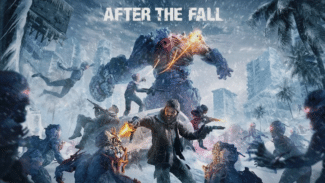After The Fall isn’t the most immersive VR shooter out there, but extensive online support and a fun gameplay loop might make it the co-op FPS to beat. Read more in our After The Fall review.
Note: Given After The Fall relies extensively on online play, social features and endgame content, we won’t be delivering our final, scored review of the game today. But we’ll be playing throughout this week to deliver our definitive verdict either on or around launch.
You’d be a liar if you said the Snowbreed of After The Fall hadn’t made you jump at least once. Vertigo Games’ latest zombie shooter is as similarly unconcerned with quick frights as the 5-year-old Arizona Sunshine, but it’s tough to tackle one of the game’s 20-ish minute scavenge missions (known as Harvest Runs), without letting out at least one unexpected squeak of surprise. It’ll happen when you round the corner into a swarm of enemies (affectionately called ‘Snowies’), or turn your back to find yourself dwarfed by one of the game’s many minibosses.
It’s a good reminder that, while this latest in a recent surge of Left 4 Dead imitators isn’t the most immersive VR experience out there, there’s still plenty to be gained from just taking our favorite genres and transplanting them into headsets. After The Fall does this incredibly well.
At its core, Vertigo’s latest feels substantially more familiar than other recent VR hits. In some ways, the game is more of a spiritual successor to L4D than even Back 4 Blood, a game with a direct familial link to Valve’s zombie series. At launch After The Fall has a set of five Harvest Runs with four difficulties to tackle in groups of four players (AI fills in if you want to play solo or with fewer friends). An introductory ‘campaign’ takes you through each environment before you’re let loose to revisit each level, earn more Harvest (the currency traded for weapons and items in the surprisingly efficient economy of a frozen-over LA) and grab weapon upgrades that will help you with harder difficulty modes.
And, well, that’s pretty much it. After The Fall’s appeal is more about jumping in with friends and having fun whilst grinding out new weapons and gear than it is making your way through a cinematic shooter story filled with immersive moments. Your interest in the game will entirely hinge on how much that idea appeals to you but, given the lack of quality long-form co-op shooters available to VR players, I’m willing to bet you’ll at least want to take a look.
It doesn’t take long to find the game’s groove. In fact, if you’d have told me this was a port of an existing flatscreen game, I’d have probably believed you; most weapons feel light as a feather, you can comfortably aim from the hip for pretty much the whole game and there’s even a near-instant reload option that sees you swinging your weapon near your chest, Arizona-style. You can switch this out for an immersive reload system closer to, say Medal of Honor or Sniper Elite VR, but we’re a long way from the weighty, more realistic zombie survival of The Walking Dead: Saints & Sinners or the more grounded, believable shootouts of Half-Life: Alyx.
In other words, when it comes to core design, After The Fall really hasn’t moved on too far from 2016. And that seems intentional.
This is an accessible shooter that casts its net wide, offering just the right balance of fun and challenge no matter your skill level. It’s a sprint more than it is a marathon; each run starts you off in a safe room — again, a lot of the game feels directly lifted from Left 4 Dead — and you’ll have about 5 – 10 minutes of gameplay between you and the next checkpoint. In that time you’ll run through the same level layouts (with some small randomized elements), with Snowbreed pouring out of holes in the ceiling and cracks in the walls. Dealing with them isn’t about strategy so much as how quickly you can pull the trigger.
Every run Harvest Run in After The Fall essentially plays out in this rollercoaster pattern. You have a few minutes of downtime as you gather ammo before sharply reacting to frantic bursts of action in which you’ll be constantly communicating about where your enemies are coming from. Things can quickly take a turn for the worse as enemy numbers overwhelm, and you’ll likely find yourself starting on the easiest difficulty, Survivor, to earn gear that helps you push on through to harder modes. Special enemy types, meanwhile, are an assortment of familiar bullet-sponges and explosive types, mixed with end-of-level bosses that require you to concentrate fire on particular areas.
There are elements of the game I’m still yet to really get to grips with. Runs across levels don’t feel all that different, but I haven’t tackled them on a wide variety of difficulties and I haven’t dived too deep into weapon customizations just yet. I also haven’t tried the PvP mode extensively yet, so check back later for thoughts on all of this.
Again, none of this feels especially advanced or unique to VR, and I suspect the game’s relative simplicity is going to leave some disappointed. Aside from the usual thrills of aiming with your hands, throwing grenades or reviving teammates with a stab of a syringe, After The Fall is light on interaction and immersion, with the real VR kick coming from the dread of seeing zombies rush towards you. But, what the game might lack in groundbreaking VR design, it makes up for in plenty of other areas.
For starters, After The Fall’s social offerings are, frankly, unmatched. Whenever you jump into the game, you’ll load into a hub world with 32 other players across a wide variety of headsets. From Quest 2 to PSVR to basically the entire gamut of PC VR devices, the game supports full cross-play, and it’s a truly incredible achievement.
Making friends and partying up across headsets also works well, at least when you’re one of only a handful of players. I could quickly jump into a hub, find a friend with their username above them and then point and click to open up a menu, add them to my friend’s list and then invite them into a party. It works really well for now, but I’ll update this review based on performance once more players start to come in.
The game’s also very good at simply keeping you invested in it. Again, this is mainly speaking for the early content, as I haven’t spent much time with the endgame, but the lure of new weapon attachments and earning enough money to buy all-new guns provided more than enough motivation for me to tackle multiple attempts at the same level.
That said, this week will be the real test of the game’s long-term staying power. I’m not convinced that 5 Harvest Runs was enough levels for launch, nor that progression goes deep enough for months-on-end play right now, but we’ll get to all that in the coming days.
After The Fall Review-In-Progress: Current Conclusion
After The Fall fills a hole in the VR market that’s been empty for far too long. It’s a polished, engaging shooter that will get its hooks into you after even just a few of its Harvest Runs thanks to the remarkable ease with which you can find friends to play with on any headset. But it’s also true that this is a mechanically straightforward shooter that’s closer to the breezy simplicity of Arizona Sunshine than it is the rivals that have long since surpassed Vertigo’s original VR hit. But that’s a calculated decision, and one that will likely work in After The Fall’s favor as it seeks to grow as large a userbase as possible. The verdict’s not quite in yet, but After The Fall might just be the co-op VR shooter to beat.
Check back for our final verdict, complete with a final score, later this week!
For more on how we arrived at this rating, read our review guidelines. What did you make of our After The Fall review? Let us know in the comments below!






